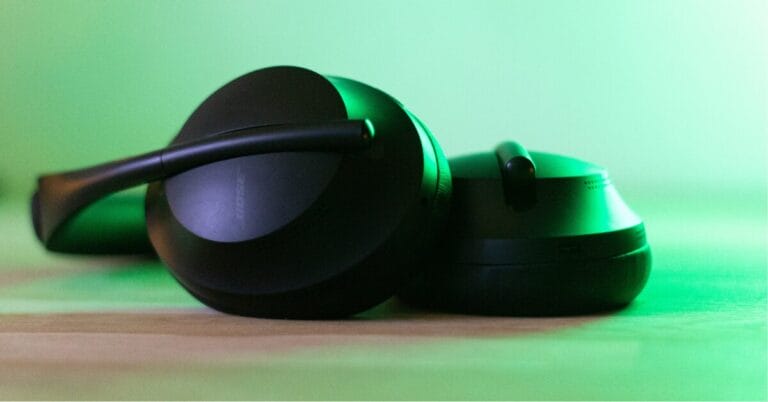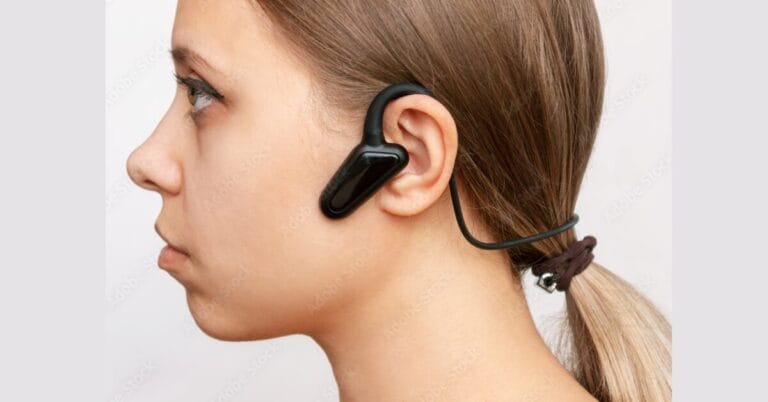Advantages and Disadvantages of Using Headphones

What Are Headphones?
Headphones have come a long way since they were first invented in the early 1900s. Originally used for radio communication and by the military, they are now essential for listening to music, gaming, working, and exercising.
Today’s headphones offer many features like noise-canceling, wireless connections, and comfortable designs to meet different needs.
Basic Types of Headphones:
- Over-Ear Headphones: Large headphones that completely cover the ears.
- On-Ear Headphones: Smaller headphones that sit directly on the ears.
- In-Ear Headphones/Earbuds: Compact devices inserted into the ear canal.
- Bone Conduction Headphones: Unique devices that transmit sound through the cheekbones.
- Noise-Canceling Headphones: These are equipped with technology to block ambient noise.
- Wireless Headphones: Use Bluetooth or other wireless technology to connect to devices.
The Growth and Popularity of Headphones:
Since their invention in the early 20th century, headphones have evolved significantly. Initially used for radio communication and military purposes, they are now a music, gaming, work, and exercise staple.
Modern headphones cater to various needs with advanced features like noise-canceling, wireless connectivity, and ergonomic designs.
Types and Advantages and Disadvantages of using headphones [pros and cons]
1. Over-Ear Headphones
Over-ear headphones cover the entire ear, providing immersive sound quality and comfort.
| Advantages | Disadvantages |
| Superior sound quality | Bulky and less portable |
| Excellent noise isolation | Can cause ear sweating during long use |
| Comfortable for extended listening | Expensive compared to other types |
2. On-Ear Headphones
On-ear headphones sit directly on the ears, offering a balance between portability and sound quality.
| Advantages | Disadvantages |
| Lightweight and portable | Less effective noise isolation |
| More affordable than over-ear models | Can cause ear discomfort over time |
| Good sound quality | Sound leakage can be an issue |
3. In-ear headphones/Earbuds
In-ear headphones are compact devices that fit snugly inside the ear canal.
| Advantages | Disadvantages |
| Highly portable and lightweight | Can cause discomfort for some users |
| Affordable options widely available | Less immersive sound quality |
| Ideal for workouts and travel | Can lead to ear infections if unclean |
4. Noise-Canceling Headphones
These headphones use active noise-canceling (ANC) technology to block ambient sounds.
| Advantages | Disadvantages |
| Blocks out background noise | More expensive than regular headphones |
| Enhances focus in noisy environments | Heavier due to built-in technology |
| Great for travel and work | Battery life can be a concern |
5. Bone Conduction Headphones
Bone conduction headphones transmit sound through vibrations on the cheekbones, leaving the ears open.
| Advantages | Disadvantages |
| Allows situational awareness | Limited sound quality |
| Suitable for outdoor activities | Can feel unusual for first-time users |
| Lightweight and comfortable | Higher cost compared to basic models |
6. Wireless vs. Wired Headphones
Wireless and wired headphones differ in their connection methods and user experience.
| Feature | Wireless Headphones | Wired Headphones |
| Portability | High | Medium |
| Connectivity | Bluetooth, no cords | Requires cable connection |
| Sound Quality | Slightly lower (depends on codec) | Superior with no compression |
| Battery Dependency | Yes | No |
| Cost | Generally higher | More affordable |
Advantages of Using Headphones
- Enhanced sound quality for personal use.
- Noise isolation for improved focus.
- Portability and convenience for travel and on-the-go use.
- Versatility for different purposes (work, gaming, exercising).
- Privacy in public spaces.
- Stylish and ergonomic designs.
- Compatibility with a variety of devices.
- A better immersive experience for entertainment.
- Availability of advanced features (e.g., noise cancelation, voice assistants).
- Customizable sound settings for personal preferences.
- Increased productivity when working in noisy environments.
- Ideal for virtual meetings and online learning.
- Reduced distractions during focused tasks.
- Perfect for physical activities like running or gym workouts.
- Wide range of models to suit all budgets.
Disadvantages of Using Headphones
- Potential hearing damage from prolonged use.
- Discomfort during extended wear.
- Lack of situational awareness.
- Battery life issues (for wireless models).
- Expensive for premium models.
- Dependence on device compatibility.
- Environmental impact (disposal and recycling concerns).
- Risk of ear infections from prolonged use.
- Sound leakage in public spaces.
- Quality differences between affordable and premium models.
- Not ideal for sharing audio experiences.
- Overuse can lead to tinnitus or other hearing issues.
- Heavier models can strain the neck or ears.
- Limited durability for low-cost models.
- Interference in wireless models (e.g., Bluetooth lag).
Comparison of Headphones and Earbuds
| Feature | Headphones | Earbuds |
| Sound Quality | Superior, more immersive | Decent, less immersive |
| Portability | Bulky, less portable | Highly portable and lightweight |
| Noise Isolation | Better (especially with over-ear models) | Moderate |
| Comfort | Comfortable for long use (over-ear) | May cause discomfort in ear canal |
| Battery Life (Wireless) | Longer | Shorter |
| Cost | Generally higher | More affordable |
| Durability | Durable, especially premium models | Less durable |
| Use Cases | Work, gaming, professional tasks | Workouts, casual listening |
| Situational Awareness | Limited | Better (leaves ear partially open) |
| Health Concerns | Can strain ears with prolonged use | Risk of infections if unclean |
Health Implications of Headphone Use
- Risk of Hearing Loss and Tinnitus: Prolonged exposure to high volumes can damage hearing.
- Impact on Mental Focus and Productivity: Overuse may lead to fatigue or reduced productivity.
- Ergonomic Concerns: Heavy headphones can cause pressure on the ears and head.
- Safe Listening Practices:
- Maintain volume levels below 85 decibels.
- Take breaks after every hour of use.
- Use properly fitting headphones for comfort.
- Regularly clean headphones to prevent infections.
My Personal Experience with Headphones
From my personal experience, headphones have been an essential part of my daily life. Whether it’s working from home, gaming, or simply enjoying music, I have explored various types of headphones over the years.
My favorite is noise-canceling over-ear headphones because of their superior sound quality and ability to create a focused environment. However, I’ve also faced challenges, such as discomfort during long use and battery issues with wireless models.
These experiences have helped me understand the importance of choosing the right headphones based on specific needs, ensuring a balance between quality and comfort.
Tips for Safe and Effective Headphone Use
- Maintain Optimal Volume and Listening Time: Keep the volume at safe levels and avoid listening for extended periods without breaks.
- Choose the Right Type of Headphones: Select headphones based on your specific needs (e.g., work, travel, exercise).
- Clean and Maintain Headphones: Regularly clean earbuds and earpads to maintain hygiene and prolong their lifespan.
- Ensure Comfort During Prolonged Usage: Opt for ergonomic designs and adjustable headbands for extended listening sessions.
Future Trends in Headphone Technology
- Advancements in Noise-Canceling Technology: Improved algorithms for better noise suppression.
- Introduction of Eco-Friendly Materials: Sustainable materials to reduce environmental impact.
- The Rise of AI and Smart Headphones: Integration of voice assistants and adaptive sound technologies.
- Bone Conduction and Hearing Aid-Integrated Headphones: Enhanced accessibility and new applications for users with hearing impairments.
- Spatial Audio and Immersive Listening Experiences: Creating 3D sound environments for a more engaging experience.
- Solar-Powered and Self-Charging Headphones: Innovative designs that reduce dependency on traditional charging methods.
Conclusion
Headphones offer numerous advantages, such as superior sound quality, portability, and versatility. However, they also have potential drawbacks, including hearing risks and environmental concerns.
Users can enjoy an optimal and safe audio experience by selecting the right type of headphones and following safe listening practices.
FAQs
Are Headphones Harmful to Hearing?
Yes, prolonged exposure to high volumes can damage hearing over time. To protect your ears, it’s essential to maintain safe volume levels (below 85 decibels) and take regular breaks.
What Are the Safest Headphones for Children?
Volume-limiting headphones designed specifically for kids are the safest. These headphones cap the maximum volume at safe levels, ensuring children’s hearing isn’t damaged.
Can Headphones Improve Productivity?
Yes, headphones can boost productivity by reducing background noise, improving focus, and enabling uninterrupted work or study sessions, especially in noisy environments.
What Is the Best Way to Choose Headphones for Work?
To choose the best headphones for work:
Opt for noise-canceling models to reduce distractions.
Ensure they are comfortable for long hours of wear.
Look for built-in microphones for calls and meetings.
Choose wireless models for more freedom of movement.
Can Headphones Cause Headaches?
Yes, tight-fitting headphones or prolonged use of heavy models can cause discomfort and headaches. Adjusting the fit or using lighter, ergonomically designed headphones can help.
What Are the Best Headphones for Kids?
The best headphones for kids are those with:
Volume-limiting features.
Lightweight and durable designs.
Comfortable ear pads suitable for extended use.
Brands like Puro and JBL offer great options for children.
How Do Noise-Canceling Headphones Work?
Noise-canceling headphones use active noise-canceling (ANC) technology, which detects external sounds through built-in microphones. They then generate sound waves that are the exact opposite (anti-phase) to cancel out the noise, creating a quieter listening experience.
What Are Safe Practices for Using Headphones Daily?
Keep volume levels below 85 decibels.
Limit listening time to no more than 60 minutes at a stretch.
Take regular breaks to rest your ears.
Clean your headphones regularly to prevent infections.
Use well-fitted, comfortable headphones to avoid strain.
Are Expensive Headphones Worth It?
Expensive headphones can be worth it if you prioritize superior sound quality, durability, advanced features (like ANC or spatial audio), and premium materials. However, for casual listening, affordable options may suffice. Always consider your specific needs and budget.






